(digital) math sat practice (copy)
1/56
Earn XP
Description and Tags
formula/content *must know* for the math portion of the dsat; content sourced from: Scalar Learning (YT), Epic Prep (YT), LearnSATMath (YT), Google, The College Panda (textbook), & ChatGPT..
Name | Mastery | Learn | Test | Matching | Spaced |
|---|
No study sessions yet.
57 Terms
point-slope form
y - y1 = m(x - x1)
*use when given slope and a coordinate
same slope, different y’s
parallel lines
circle formula
(x - h)2 + (y - k)2 = r2
(h, k) = center of the circle
slope of a line when given coordinates
m = y2 - y1 / x2 - x1
slope intercept form
y = mx + b
m = slope → rise/run
b = y-intercept
midpoint formula
(x1 + x2 / 2 , y1 + y2 / 2)
*midpoint = average of two points
distance formula purpose
to find radius of circle, given center point/one exterior; to find hypotenuse w/o pythagorean theorem
distance formula
d = √(x2 - x1)2 + (y2 - y1)2
length of an arc formula
L = (n/360)2πr
n = angle made by r; L = crust of the pizza slice
area of a sector
A = (n/360)πr2
A = area of the slice of pizza
quadratic formula
x = 1/2(a) (-b ± √b2-4(a)(c))
when quadratic equation = 0, x values are the solution
quadratic standard form
y = ax2 + bx + c
when quadratic equation = 0, x values are the solution
soh cah toa
sine = opposite/hypotenuse
cosecant = hypotenuse/opposite
cosine = adjacent/hypotenuse
secant = hypotenuse/adjacent
tangent = opposite/adjacent
cotangent = adjacent / opposite
similar triangles (same angles + proportionate side lengths)
sine of corresponding angles are equal
probability
number of favorable outcomes / total number of outcomes
exponential growth
y = a(1 + r)t
a = initial value; r = growth rate; t = time
exponential decay
y = a(1 - r)t
a = initial value; r = growth rate; t = time
vertex of a parabola formula when in quadratic standard form
(x, y)
x = -b/2a
y = that x value plugged back into the original equation (that you got the b and a values from)
vertex form
y = a(x - h) + k
vertex: (h, k)
pythagorean theorem
a2 + b2 = c2
a & b = legs
c = hypotenuse
special right triangles
45º-45º-90º → leg 1: x, leg 2: x, hypotenuse: x√2
hypotenuse ÷ √2 = leg
30º-60º-90º → small leg: x, big leg: x√3, hypotenuse: 2x
small leg x √3 = big leg
big leg ÷ √3 = small leg
small leg x 2 = hypotenuse
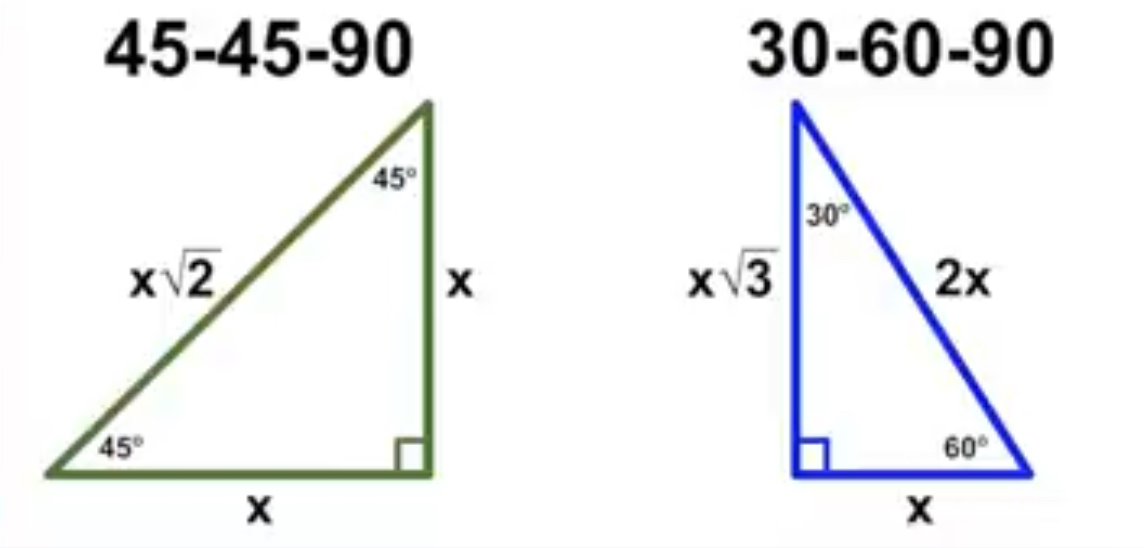
distance formula (rate)
d = rt
d = distance; r = rate (rate = speed); t = time
*units of rate must equal units of time
sin/cosine relationship
*sin(x) = cos(90 - x)
x = angle
90 - x = complement of that angle
sin(10) = cos(80)
sin(20) = cos(70)
sin(30) = cos(60)
sin(40) = cos(50)
sin(50) = cos(40)
sin(60) = cos(30)
sin(70) = cos(20)
sin(80) = cos(10)
*equals 90º → definition of complementary angles: two angles that up to 90º
sum of solutions of quadratic
0 = ax2 + bx + c
sum of solutions = -b/a
product of solutions of quadratic
0 = ax2 + bx + c
product of solutions: c/a
discriminant (of quadratic)
0 = ax2 + bx + c
b2 - 4(a)(c)
discriminant = stuff under the radical in quadratic formula
find number of solutions (quadratic)
use discriminant to solve
x < 0 (negative; imaginary solutions) → no real solution
x = 0 → one real solution
x > 0 (positive) → two real solutions
area of equilateral triangle
∆ → all sides equal s
area of equilateral triangle = s2√3/4
pythagorean triples
3-4-5
6, 8, 10 (× 2)
9, 12, 15 (× 3)
12, 16, 20 (× 4)
15, 20, 25 (× 5)
5-12-13
10, 24, 26 (× 2)
15, 36, 39 (× 3)
20, 48, 52 (× 4)
25, 60, 65 (× 5)
7-24-25
14, 48, 50 (× 2)
21, 72, 75 (× 3)
28, 96, 100 (× 4)
35, 120, 125 (× 5)
8-15-17
16, 30, 34 (× 2)
24, 45, 51 (× 3)
32, 60, 68 (× 4)
40, 75, 85 (× 5)
*multiply all sides by a value to find the sides when you know its a pythagorean triple
perpendicular slope
slope → m = a/b
perpendicular slope (opposite reciprocal of slope) → m = -b/a
parallel slope
slope → m = a/b
parallel slope → m = a/b
*slopes are the same
sum of angles formula (for any polygon)
sum = (n - 2)180º
n = number of sides
rational functions
x-intercept
equation: set numerator equal to zero
graph: where the line touches the x-axis (same as the zeroes)
y-intercept
equation: plug in 0 for x in the equation
graph: where the line touches the y-axis
vertical asymptote
equation: set denominator equal to zero
graph: find the line the function is approaching but never meeting
horizontal asymptote
equation: f the degree of the numerator is less than the degree of the denominator, it’s y = 0; if the degree of the numerator is equal to the degree of the denominator, y = leading coefficient/leading coefficient; if the degree of the numerator is greater than the degree of the denominator, there is no horizontal asymptote)
graph: find the line the function is approaching but never meeting
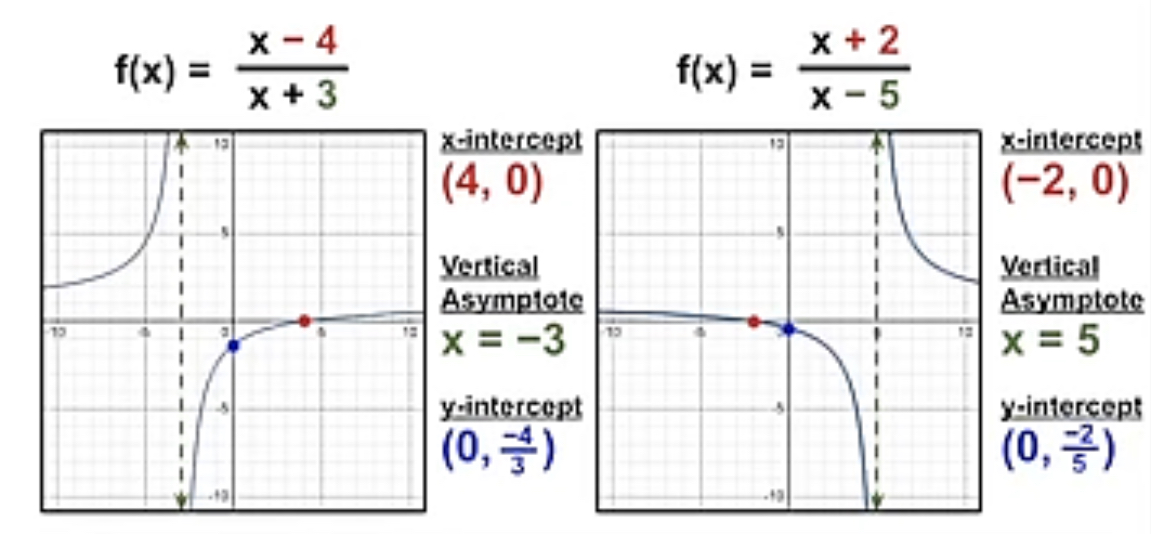
triangle congruence theorems
SSS - side-side-side
SAS - side-angle-side
ASA - angle-side-angle
AAS - angle-angle-side
HL - hypotenuse-leg
*must be in this exact order
triangle similarity theorems
SSS - side-side-side
SAS - side-angle-side (congruent angles, proportionate sides)
AA - angle-angle
*sides proportionate and not congruent; angles are always congruent
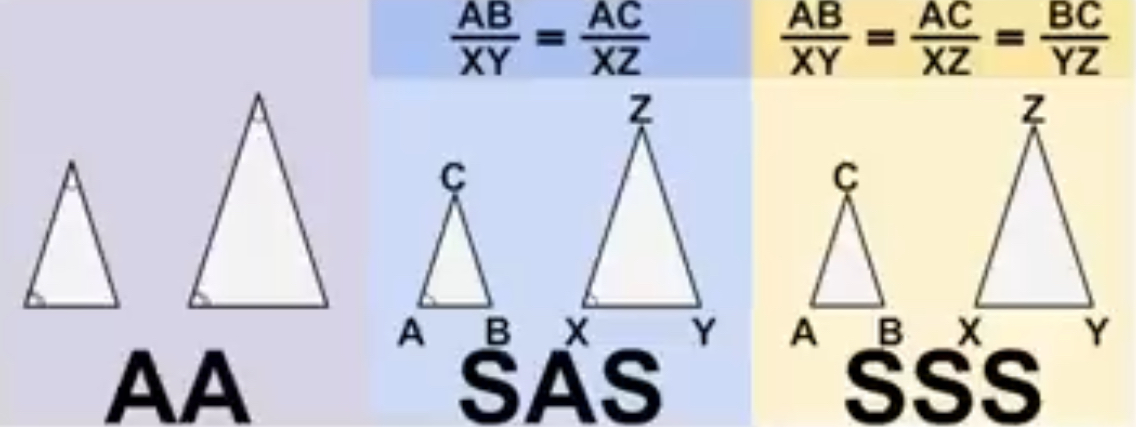
unit circle
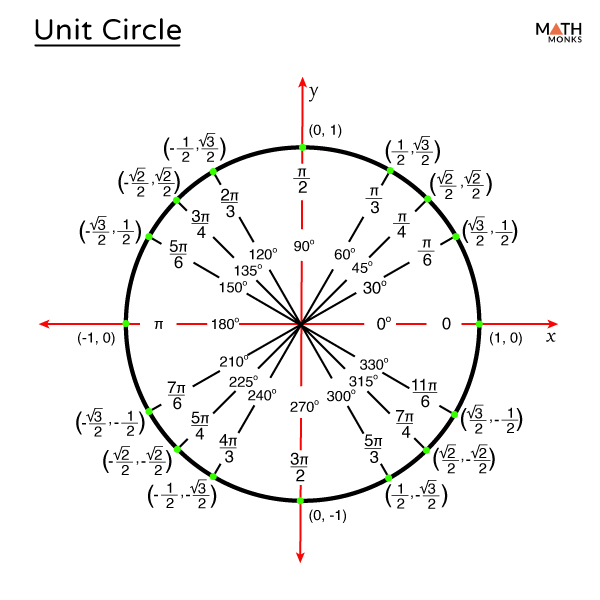
sin(Θ) = y
cos(Θ) = x
tan(Θ) = y/x
exponent rules (7)
xa • xb → xa+b
(xa)b → xa•b
xa / xb → xa-b
x-a → 1 / xa
x0 → 1
x1 → x
xa/b → b√xa
absolute value
|ax - b| = c
two equations:
ax - b = c
ax - b = -c
solve for x → two solutions
inequalities
-ax - b < c
*-ax < b+c
*when dividing (or multiplying) -a on both sides, you have to switch the sign
answer: x > b+c/a
solutions in systems of equations
no solution = parallel lines (same slope)
infinite solutions = same line (same slope, same y-intercept)
one solution = lines intersect at a single point (different slopes)
inscribed angle theorem
any inscribed angle that extends from the same arc as the center angle will always be ½ of the center angle
inscribed angle theorem of the diameter
if a point lies on the circumference and is connected to the endpoints of the diameter, it forms a right angle with the diameter
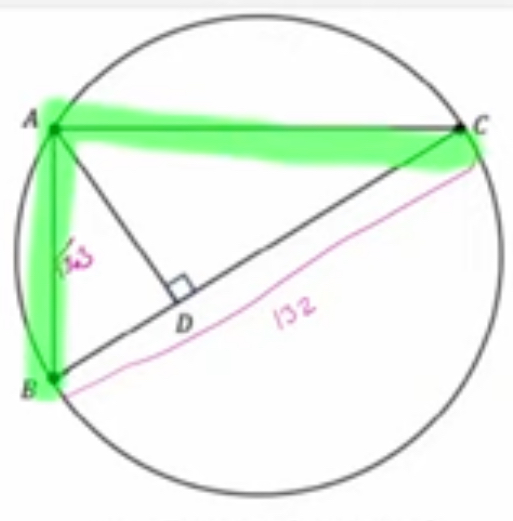
simple interest formula
A = p (1 ± r)t
A = amount; p = principal amount; r = rate; t = time
compound interest formula
A = p (1 ± r/n)nt
A = amount; p = principal amount; r = rate; n = number of times interest is applied per time period; t = time
integer vs. non-integer
integer: positive/negative whole number (including zero)
non-integer: not a positive/negative whole number/zero; decimal or fraction
use vertex form for quadratic (minimum or maximum)
y = a(x - h)² + k
positive a: parabola opens upwards and k represents the minimum value
negative a: parabola opens downwards and k represents the maximum value.
when there’s one solution between a quadratic and horizontal line
the solution is at the vertex
when to use desmos for no solution problems
quadratic = YES
systems of equations (linear) = NO (just make the slopes equal)
percent change formula
percent change = 100% (new value - original value / original value)
*if the problem is worded as “percent greater/less than,” the quantity that comes after “than” should be taken as the original value
p% of x
p/100 × x
p% greater than x
(1 + p/100)x
p% less than x
(1 - p/100)x
square inscribed in a circle
the diagonal of a square is equal to the diameter of the circle it is incribed in
square relationship between its diagonal and side lengths (formula)
d = s√2
d = diagonal; s = side length
when to use desmos
finding the vertex
x/y-intercepts
quadratics that intersect at 1/0 points
finding (basic) mean/median
finding points on a circle
systems of equations/inequalities
number of solutions
180º
equals π radians
radians/degrees conversion
radian = degree × 180/π
degree = radian × π/180